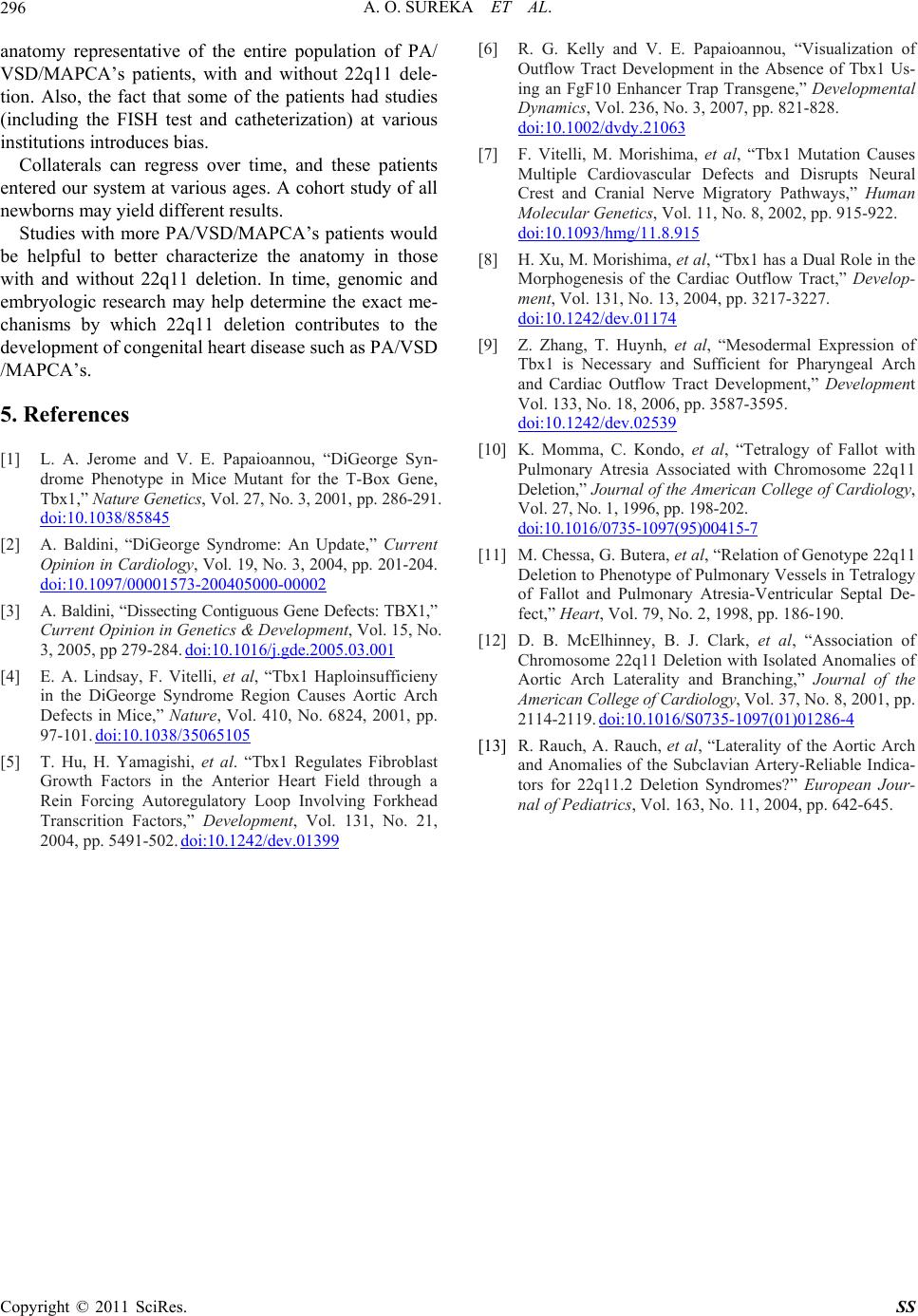
A. O. SUREKA ET AL.
Copyright © 2011 SciRes. SS
296
anatomy representative of the entire population of PA/
VSD/MAPCA’s patients, with and without 22q11 dele-
tion. Also, the fact that some of the patients had studies
(including the FISH test and catheterization) at various
institutions introduces bias.
Collaterals can regress over time, and these patients
entered our system at various ages. A cohort study of all
newborns may yield different results.
Studies with more PA/VSD/MAPCA’s patients would
be helpful to better characterize the anatomy in those
with and without 22q11 deletion. In time, genomic and
embryologic research may help determine the exact me-
chanisms by which 22q11 deletion contributes to the
development of congenital heart disease such as PA/VSD
/MAPCA’s.
5. References
[1] L. A. Jerome and V. E. Papaioannou, “DiGeorge Syn-
drome Phenotype in Mice Mutant for the T-Box Gene,
Tbx1,” Nature Genetics, Vol. 27, No. 3, 2001, pp. 286-291.
doi:10.1038/85845
[2] A. Baldini, “DiGeorge Syndrome: An Update,” Current
Opinion in Cardiology, Vol. 19, No. 3, 20 04, pp. 201-204.
doi:10.1097/00001573-200405000-00002
[3] A. Baldini, “Dissecting Contiguous Gene Defects: TBX1,”
Current Opinion in Genetics & Development, Vol. 15, No.
3, 2005, pp 279-284. doi:10.1016/j.gde.2005.03.001
[4] E. A. Lindsay, F. Vitelli, et al, “Tbx1 Haploinsufficieny
in the DiGeorge Syndrome Region Causes Aortic Arch
Defects in Mice,” Nature, Vol. 410, No. 6824, 2001, pp.
97-101. doi:10.1038/35065105
[5] T. Hu, H. Yamagishi, et al. “Tbx1 Regulates Fibroblast
Growth Factors in the Anterior Heart Field through a
Rein Forcing Autoregulatory Loop Involving Forkhead
Transcrition Factors,” Development, Vol. 131, No. 21,
2004, pp. 5491-502. doi:10.1242/dev.01399
[6] R. G. Kelly and V. E. Papaioannou, “Visualization of
Outflow Tract Development in the Absence of Tbx1 Us-
ing an FgF10 Enhancer Trap Transgene,” Developmental
Dynamics, Vol. 236, No. 3, 2007, pp. 821-828.
doi:10.1002/dvdy.21063
[7] F. Vitelli, M. Morishima, et al, “Tbx1 Mutation Causes
Multiple Cardiovascular Defects and Disrupts Neural
Crest and Cranial Nerve Migratory Pathways,” Human
Molecular Genetics, Vol. 11, No. 8, 2002, pp. 915-922.
doi:10.1093/hmg/11.8.915
[8] H. Xu, M. Morishima, et al, “Tbx1 has a Dual Role in the
Morphogenesis of the Cardiac Outflow Tract,” Develop-
ment, Vol. 131, No. 13, 2004, pp. 3217-3227.
doi:10.1242/dev.01174
[9] Z. Zhang, T. Huynh, et al, “Mesodermal Expression of
Tbx1 is Necessary and Sufficient for Pharyngeal Arch
and Cardiac Outflow Tract Development,” Development
Vol. 133, No. 18, 2006, pp. 3587-3595.
doi:10.1242/dev.02539
[10] K. Momma, C. Kondo, et al, “Tetralogy of Fallot with
Pulmonary Atresia Associated with Chromosome 22q11
Deletion,” Journal of the Americ an College of Cardiology,
Vol. 27, No. 1, 1996, pp. 198-202.
doi:10.1016/0735-1097( 95)0041 5-7
[11] M. Chessa, G. Butera, et al, “Relation of Genotype 22q11
Deletion to Phenotype of Pulmonary Vessels in Tetralogy
of Fallot and Pulmonary Atresia-Ventricular Septal De-
fect,” Heart, Vol. 79, No. 2, 1998, pp. 186-190.
[12] D. B. McElhinney, B. J. Clark, et al, “Association of
Chromosome 22q11 Deletion with Isolated Anomalies of
Aortic Arch Laterality and Branching,” Journal of the
American College of Cardiology, Vol. 37, No. 8, 2001, pp.
2114-2119. doi:10.1016/S0735-1097(01)01286-4
[13] R. Rauch, A. Rauch, et al, “Laterality of the Aortic Arch
and Anomalies of the Subclavian Artery-Reliable Indica-
tors for 22q11.2 Deletion Syndromes?” European Jour-
nal of Pediatrics, Vol. 163, No. 11, 2004, pp. 642-645.